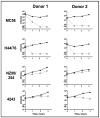Factor H and neisserial pathogenesis
- PMID: 19388163
- PMCID: PMC2768413
- DOI: 10.1016/j.vaccine.2008.11.060
Factor H and neisserial pathogenesis
Abstract
Both Neisseria gonorrhoeae and N. meningitidis bind to factor H which enhances their ability to evade complement-dependent killing. While porin is the ligand for human fH on gonococci, meningococci use a lipoprotein called factor H binding protein (fHbp) to bind to factor H and enhance their ability to evade complement-dependent killing. This protein is currently being intensively investigated as a meningococcal vaccine candidate antigen. Consistent with the observation that meningococci cause natural infection only in humans, the organism resists human complement, and are more readily killed by complement from lower animals. This human species-specific complement evasion has important implications for evaluation of vaccine-elicited antibodies using non-human complement sources and development of animal models of disease.
Figures


References
-
- Kazatchkine MD, Fearon DT, Austen KF. Human alternative complement pathway: membrane-associated sialic acid regulates the competition between B and beta1 H for cell-bound C3b. J Immunol. 1979;122(1):75–81. - PubMed
Publication types
MeSH terms
Substances
Grants and funding
LinkOut - more resources
Full Text Sources
Other Literature Sources
Medical
Miscellaneous

